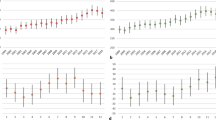Abstract
Previous attempts to find relationships between weather and parturition (childbirth) and its onset (the beginning of labor pains) have revealed, firstly, limited but statistically significant relationships between weather conditions much colder than the day before, with high winds and low pressure, and increased onsets; and secondly, increased numbers of childbirths during periods of atmospheric pressure rise (highly statistically significant). To test these findings, this study examined weather data coincident childbirth data from a hospital at Bryan-College Station, Texas (for a period of 30 cool months from 1987 to 1992). Tests for (1) days of cold fronts, (2) a day before and a day after the cold front, (3) days with large temperature increases, and (4) decreases from the day before revealed no relationship with mean daily rate of onset. Cold days with high winds and low pressure had significantly fewer onsets, a result that is the opposite of previous findings. The postulated relationship between periods of pressure rise and increased birth frequency was negative, i.e., significantly fewer births occurred at those times — again, the opposite of the apparent occurrence in an earlier study. The coincidence of diurnal variations in both atmospheric pressure and frequency of childbirths, was shown to account for fairly strong negative associations between the two variables. This same reasoning might explain the positive association found in an earlier study. A comparison has been made between childbirth and onset as the response variable, and the advantage is emphasized of using data from women whose labor is not induced.
Similar content being viewed by others
References
Berry FA, Bollary E, Beers R (eds) (1945) Handbook of meteorology. McGraw-Hill book Co., New York
Driscoll DM (1990) A perspective on weather-human response relationships. Int J Environ Stud 36:19–25
Driscoll DM, Merker D (1984) A search for associations between weather and the onset of human parturition. J Int Soc Biometeorol 28:211–224
Reynolds SRM, Hendricks SH (1971) Physiology of uterine contractions and onset of labor. In: Danforth DN (ed) Textbook of obstetrics and gynecology. Harper and Row, New York
Reiter R (1952) Wetter und Zahl der Geburten, “Due Tagliche Geburtenziffer Bayerns und Ihre Beziehung zu Biometeorologischen Indikatoren”. Zentralblatt Gynokol 6:1605–1609
Sutton DH (1945) Gestation period. Med J Aust June 16:611–613
Trapasso LM, Kinkel B (1986) Barometric pressure: a trigger mechanism in human childbirth. Professional paper no. 17, Department of Geography and Geology, Indiana State University
Trapasso LM, Yurchisin MJ (1988) Weather and childbirth: is there a link? The Female Patient 13:33–37
Author information
Authors and Affiliations
Rights and permissions
About this article
Cite this article
Driscoll, D.M. Weather and childbirth: A further search for relationships. Int J Biometeorol 38, 152–155 (1995). https://doi.org/10.1007/BF01208493
Received:
Revised:
Accepted:
Issue Date:
DOI: https://doi.org/10.1007/BF01208493




